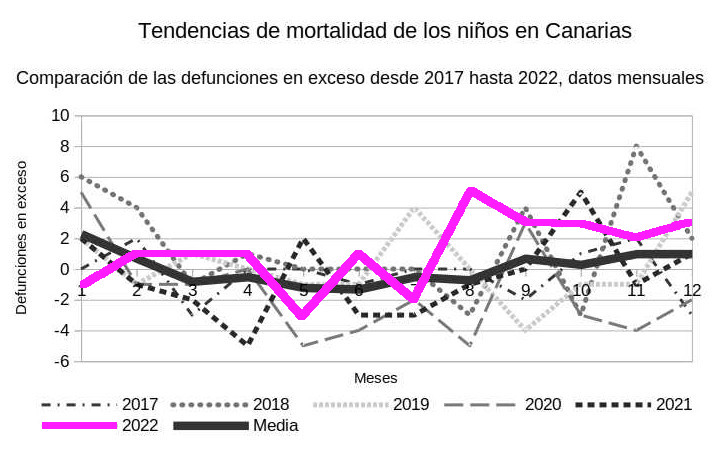1.

The so far puzzling increase in deaths in Spain and Europe in 2022
| GRAPH 1 The cumulative excess
mortality in Europe for all age groups
compared to age groups 0 - 14 and 15 - 44 in 2020 (grey), 2021 (dark blue) and 2022 (light blue).6 |
|
(Decreases in green, increases in
red. Colours are my own,
RW.)
GRAPH 2 Excess mortality in Spain,
all age groups compared
with age group 0 - 14 years,
2022, monthly data8 GRAPH 4 Canary Islands, age group
0-14 years,
01.01.2017 to 31.12.2022, monthly data10  For children, in 2022, with a negative value until July, there is a very steep, long-lasting and atypical rise from August onwards, which does not reach 2018 values. For most of 2022, excess mortality is above the average for the years since 2017. The trend does not continue in January 2023, but does in February. |
|
|
| TABLE 2 Spain, changes in deaths 2019
- 2020 - 2021,
all ages and age groups up to 29 years of age11 Own calculation of variations, R.W. Significant decreases in green, significant increases in red. [For a complete overview see TABLES 2 to 4 under  1.2.2.2.
2017 - 2022 (abajo, detallado) La evolución de las
defunciones desde 2019 y sus variaciones] 1.2.2.2.
2017 - 2022 (abajo, detallado) La evolución de las
defunciones desde 2019 y sus variaciones]
|
|||||||||||||||||||||||||||||||||||||||||||||||||||||||||||||||||||||||||||||||||||||||||||||||||||
| Group | Increase
deaths |
Main
causes |
|||||
| Cause |
Increase | Cause | Increase | Cause | Increase | ||
| 5-9
years |
31 persons 22,3% |
Tumours | 19 persons 35% |
Of these: Leukaemia |
13 persons 93% |
Blood | 4 persons 200% |
| Other malign tumours of he skin and soft tissues | 6 persons 200% |
||||||
| 10-14 years | 26 persons 13,8% |
Suicides | 9 persons 69% |
Bone tumours |
5
persons 42% |
||
| 15-19 years | 59 persons 15,6% |
Accidents | 51 persons 51% |
Digestive
system |
11 persons 220% |
Nervous
system |
14 persons 37% |
| 20-24 years | 88 persons 14,4% |
Accidents Of these: Other transport accidents |
98 persons 31% 26 persons 289% |
Circulation | 14 persons 42% |
Suicides | 26
persons 26% |
Notes
1) https://euromomo.eu/
(updated every Thursday) presents itself like this:
"EuroMOMO is a European mortality monitoring activity, aiming to detect
and measure excess deaths related to seasonal influenza, pandemics and
other public health threats.
Official national mortality statistics are provided weekly from the 28
European countries or subnational regions in the EuroMOMO collaborative
network, supported by the European Centre for Disease Prevention and
Control (ECDC) and the World Health Organization (WHO), and hosted by
Statens Serum Institut, Denmark."
2) EuroMOMO: https://euromomo.eu/bulletins/2022-43/,
last accessed 05/11/2022.
See also 4. Materials.
3) https://momo.isciii.es/panel_momo/#section-momo,
updated every Thursday.
The stated objective of the "all-cause daily mortality monitoring system
(MoMo)" of the Instituto de Salud Carlos III (MoMo-ISCIII) - based on
the "framework of the 'Preventive action plan against the effects of
excessive temperatures'.... - was to identify deviations of observed
daily mortality from that expected from historical mortality series.
Subsequently, its use was extended to other situations throughout the
year to indirectly estimate the impact of any major public health
event."
(Own translation, R.W.)
(https://www.isciii.es/QueHacemos/Servicios/VigilanciaSaludPublicaRENAVE/EnfermedadesTransmisibles/MoMo/Paginas/MoMo.aspx)
4) For example:
El exceso de mortalidad infantil llega al Parlamento Canario
(Excessive infant mortality reaches the Canary Islands Parliament),
12/10/2022,
https://diario16.com/el-exceso-de-mortalidad-infantil-llega-al-parlamento-canario/
Salud Pública investiga el exceso de mortalidad de niños en
Canarias (Public Health investigates excess child mortality in the
Canary Islands), EFE, 10/10/2022,
https://diariodeavisos.elespanol.com/2022/10/mortalidad-de-ninos-en-canarias/
Own translation, R.W.
5) https://www.ine.es/index.htm
6) EuroMOMO
Bulletin, Week 43, 2022,
https://euromomo.eu/bulletins/2022-43, last
accessed 05/11/2022
7) MoMoISCIII
data, downloaded from https://momo.isciii.es/panel_momo/#section-momo
on 06/01/2023.
8)
MoMoISCIII
data, downloaded from https://momo.isciii.es/panel_momo/#section-momo
on 06/01/2023.
9) MoMoISCIII
data, downloaded from https://momo.isciii.es/panel_momo/#section-momo
on 07/01/2023.
See also 4. Materials.
10) MoMoISCIII data,
downloaded from https://momo.isciii.es/panel_momo/#section-momo
on 07/01/2023.
See also 4. Materials.
11) https://www.ine.es/dyngs/INEbase/operacion.htm?c=Estadistica_C&cid=1254736176780&menu=resultados&idp=1254735573175#!tabs-1254736194710
Select "Definitivos" -->
-->Series nacionales, por comunidad autónoma y
provincia de residencia (capítulos y lista reducida) --->Defunciones
por causas (lista reducida) por sexo y grupos de edad -->
"Seleccionar todos" (everything) in "Causa de muerte" (death), in
"Sexo" choose "Total", in "Edad" (age) select the desired age groups,
for example from 1 to 24 years, and in "Periodo" select the years. A
table for download is produced, in this case also downloaded on the
01/01/2023 and documented in 4. Materials, and the
corresponding graph.
12) https://www.ine.es/prensa/edcm_2021.pdf,
page 12. See also in 4.
Materials.
13) https://www.ine.es/dynt3/inebase/es/index.htm?padre=9035&capsel=9036
14) https://www.ine.es/prensa/edcm_2021.pdf, p.
13. See also in 4.
Materials.
15) This hypothesis can be considered
falsified in view of the lack of relevance of infectious diseases as a
cause of death in the age groups up to 24 years.
Siehe
auch allgemein:
https://medical-tribune.ch/10124898/2022/kinder-und-covid-19-wie-geht-es-weiter/
21) https://www.eldiario.es/sociedad/venta-antidepresivos-dispara-espana-10-ano_1_9312450.html
https://fefe.com/wp-content/uploads/2022/09/Ob-julio-22.pdf
22) https://www.eldiario.es/sociedad/pandemia-arrasa-salud-mental-menores_1_7996083.html